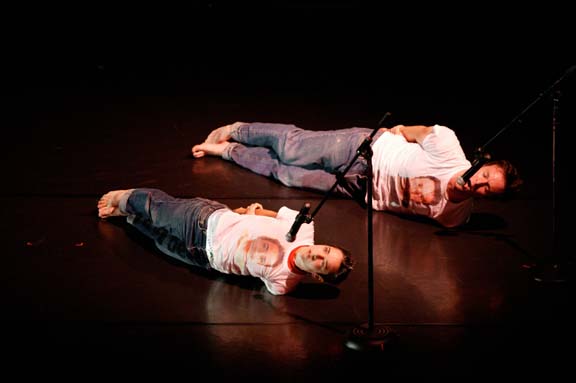“Faker” in SCUBA: Best of Three
To find out what this title means, read on! (Hint: it's Camille Lefevre's take on Morgan Thorson's work.)

Last weekend, SCUBA made its first stop at the Southern Theater with three different perspectives on contemporary concert dance. What’s that, you say? The fourth annual SCUBA Touring Network—which sends out regionally established, nationally emerging dance artists from Minneapolis, Seattle and San Francisco to new venues and audiences (Philadelphia joins next year)—began its rounds. And this year, the network has produced an evening of original, memorable performances.
Works by out-of-town choreographers Paige Barnes (Seattle) and Manuelito Biag (San Francisco) were captivating variations on a modern-dance idiom of expressive, yet abstract movement. Both dance makers have strong, clear movement vocabularies that add up to distinctive choreographic identities. Their works were also flawlessly performed by dancers who inhabited the choreography like a kinetic skin.
But—okay, go ahead and call me a cheerleader for the hometown team–really the most adventurous, inventive and dynamic work on the program was by Minneapolis choreographer Morgan Thorson: a reprise of “Faker,” which premiered during last year’s Momentum series, and it looked better than ever. Here’s why I think Thorson’s work trumped the others:
Barnes’ duet “Molt” was an intensely physical work comprised of fast, articulate movements imploding inside the dancers’ bodies. Barnes also took a step toward multi-media collaboration by incorporating on-stage musicians, video and décor of four hanging, translucent panels. Biag’s trio “Making Invisible,” for his company, SHIFT.>>>Physical Theater, was a pure movement trio of long flowing moves and limbs flung gently into space.
In contrast to this excellent but perhaps narrow formalism, Thorson’s choreography is a postmodern movement pastiche less indebted to modern dance, or even the bold experiments in the essentials of everyday movement conducted by the Judson Dance Theater in the 1960s and 70s. Thorson seemingly finds her inspiration in the quirky unconscious gestures that manifest as a part of personality (alone or during [often awkward] social interactions); the deliberate personas one publicly performs to project a certain aspect of identity; and the wide range of postures and movements disseminated via the media—from super-hero poses to playing air guitar—that instantly signal meaning in postmodern culture.
Here’s how I imagine Thorson’s formula for “Faker.” Abstract and combine those movements. Give to dancers in a range of sizes, shapes and heights, and with a range of distinctive movement styles. Apply to postmodern detritus: an eclectic selection of popular and classical music, spoken text, text on the wall from an overhead projector, rubber bands, carpet, televisions. Throw in some really fine karaoke singing—done from a prone position on the floor. String it all together in a series of disjunctive vignettes about fame, celebrity, entrapment and dance making. Voila. It’s not always pretty, but it’s hilarious, provocative and powerful.
“Faker” wasn’t perfect. The scene in which the dancers practice what we assume is a dance performance on the television sets in front of them (the screens are actually blank) is too long. The underwear duet on the red carpet makes sense—and it’s goofily lovely; but otherwise, the dancers wrestling with carpet is a nonsequitor. So are the rubber bands. And the “Welcome to the Southern Theater” master-of-ceremonies announcement midway through is hokey and awkward.
But the performances are astounding. Karen Sherman and Chris Schlichting’s karaoke duet to “Up Where We Belong” would be a Grammy winner if there were such a category, as they really can sing. In her lounge-lizard act—complete with go-go girls—Sherman channels every pelvis-wriggling, sleeze-oozing, girl-ogling, audience-seducing lounge singer with impeccable gestural precision.
In her drum-solo duet with on-stage drummer Ryan Billig, she’s simultaneously drum, stick and drummer in a tour de force of fervor, fearlessness and physical ferocity. And Kristin Van Loon’s funny and worrisome series of obsessive gestures conveys a sense of entrapment underscored by the music.
Through the entire piece, a keen sense of process, of the stops and starts that occur during the making of a dance, is underscored. The dancers slip out of performance mode and talk to each other. Thorson, in a blue worker jumpsuit, prowls the perimeter and issues orders. In addition, her thorough use of stage space—including doorways and cracks in the walls—is marvelous.
In contrast, Barnes’ on-stage musician didn’t interact with the performers. And as the piece ended with a video of a young girl dancing in a semi-demolished building (projected on the translucent panels), Barnes and Beth Graczyk remained kneeling quietly with their eyes closed. This stillness was a radical change from their breathtakingly fast and furious movement, which either sliced out razor-sharp from their limbs or pulsed with dangerous electricity through their bodies.
Was the contrast about juxtaposing the pristine with decay? professional dancing with goofing around? the body’s stillness with video movement? Perhaps. But in the end, dancers and video remained two separate and unrelated entities—a missed opportunity. As fractured as “Faker” was, it almost always seemed to make sense.
Southern Theater website: www.southerntheater.org